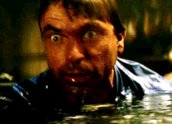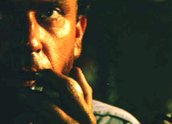


Dead Calm (1989)
Synopsis
Australian naval officer John Ingram (Sam Neill) and his young wife Rae (Nicole Kidman) take their yacht to sea to recover from the death of a child. Becalmed in mid-ocean, they rescue a frightened young American, Hughie Warriner (Billy Zane), from a sinking schooner. While John investigates the other boat, the psychotic Hughie takes control of the yacht and leaves him behind.
Curator’s notes
Dead Calm is basically a dangerous hitchhiker story, set on water. The thriller elements are reduced to as few as possible – two boats, two men, one woman, one dog, and a cruel sea. Within this minimalist framework, the film carries a lot of subtext, to do with grief, passion and a form of resurrection. Rae is a broken woman at the start, marooned on a yacht with a husband who doesn’t know how angry he is. They have lost their son in a car accident in which she was driving. They are not a happy family. The stranger Hughie brings his own happy family fantasy with him.
Some of the creepiness of Zane’s performance comes from his willingness to believe Rae actually fancies him. They do have a sexual encounter in the film, but it’s shown as Rae’s ultimate self-sacrifice – and the turning point, in terms of her finding her own strength. The script, adapted from a 1963 novel by little known American pulp writer Charles Williams, plays with the conventions of the sun-sex-sailing fantasy. An idyll becomes a nightmare, and the sea (usually depicted in literature as female) rises up to punish them – or perhaps to aid another female. (The novel had been filmed already, in 1968 by Orson Welles, but that film was never completed).
Nicole Kidman was 20 when she was cast in Dead Calm in 1987. She had just become an overnight star in Australia in Kennedy Miller’s TV mini-series Vietnam. Within a year of Dead Calm’s opening in 1989, she was in Hollywood, starring opposite Tom Cruise in Days of Thunder – partly as a result of her performance in this film. Dead Calm also opened the Hollywood door for director Noyce. He would not make another film in Australia until Rabbit-Proof Fence, 13 years later.
- Overview
- Curator’s notes
- Video 3 clips

- Principal credits
- Find a copy
- Make a comment
- Map
- Reviews 1



